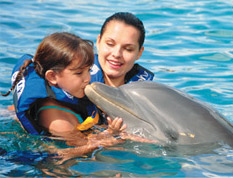I've
written about animal intelligence and, specifically, the intelligenceof dogs. I've also made a point of how the pattern of underestimating
the smarts of non-human creatures is endemic to the scientific
community. When a person raves about the smarts of their dog,
scientists often dismiss it as anthropomorphizing, assigning human
characteristics to hard-wired behavior.
Well,
those scientists may eventually move their animal IQ bar past even
the high marks that ordinary pet owners ascribe to their pooches.
Off
the coast of Scotland, a group of scientists have been recording the
speech of a group of dolphins. They discovered that the dolphins all
have names!
I can spare you the details of how they figured it out,
but they've clearly demonstrated that the dolphins address each other by name, and the
dolphin being addressed responds when the others do not. Sound
familiar? When Tom calls out to Dick but not to Harry, Dick pays
attention while Harry keeps watching the game.
It
doesn't take much thinking about this to realize that it's a big
deal, even to those who have thought all along that animals are
smarter than we've previously thought.
The
study also states that Bottlenose dolphins appear to be unique as
non-human mammals in this regard.
Unique? How do they know? In the past, it was assumed that only
humans exhibit a wide range of abilities such as tool use and tool
making. It was also believed that only humans have complex social
structures and a wide range of emotions. These beliefs have since
been debunked.
Dolphins,
elephants, chimpanzees, bonobos and others are far smarter than
people once thought. Once we understand other animals better, we may
discover that they have names, too.
And
dogs, while not in the same league in some ways, surpass all other
animals in their ability to understand what humans want.
If
you think animals are very smart, increasing evidence suggests that
you are right.




Is that *your* dog, Spot on the cover?
ReplyDeleteIt almost could be Owen's dog Spot. Although the Dane on the book looks to be a Merle, which is very much like a Harlequin. The difference is that a Merle has black spots on a gray background, and a Harlequin has black spots on a white background. Either way, it certainly is a great portrait of a Great Dane, isn't it?!
Delete